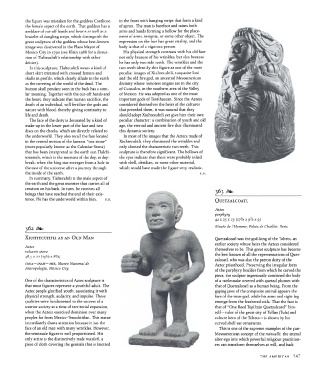Page 548 - Art In The Age Of Exploration (Great Section on Chinese Art Ming Dynasty)
P. 548
the figure was mistaken for the goddess Coatlicue, in the front with hanging strips that form a kind
the female aspect of the earth. That goddess has a of apron. The man is barefoot and raises both
necklace of cut-off hands and hearts as well as a arms and hands forming a hollow for the place-
bracelet of dangling strips, which distinguish the ment of arms, insignia, or some other object. The
great sculpture of the goddess whose best-known expression on the face has great vitality, and the
image was discovered in the Plaza Mayor of body is that of a vigorous person.
Mexico City in 1790 (see Klein 1988 for a discus- His physical strength contrasts with his old face
sion of Tlaltecuhtli's relationship with other not only because of his wrinkles, but also because
deities). he has only two side teeth. The wrinkles and the
In this sculpture, Tlaltecuhtli wears a kind of two teeth identify this figure as one of the most
short skirt trimmed with crossed femurs and peculiar images of Xiuhtecuhtli, turquoise lord
skulls in profile, which clearly allude to the earth and the old fire god, an ancestral Mesoamerican
as the covering of the world of the dead. The divinity whose remotest origins are in the city
human skull pendant seen in the back has a simi- of Cuicuilco, in the southern area of the Valley
lar meaning. Together with the cut-off hands and of Mexico. He was adopted as one of the most
the heart, they indicate that human sacrifice, the important gods of Teotihuacan. Since the Aztecs
death of an individual, will fertilize the gods and considered themselves the heirs of the cultures
nature with blood, thereby giving continuity to that preceded them, it was natural that they
life and death. should adopt Xiuhtecuhtli yet give him their own
The face of the deity is decorated by a kind of peculiar character: a combination of youth and old
make-up in the lower part of the face and two age, the eternal and ancient fire that illuminated
discs on the cheeks, which are directly related to this dynamic society.
the underworld. They also recall the face located In most of the images that the Aztecs made of
in the central section of the famous "sun stone" Xiuhtecuhtli, they eliminated the wrinkles and
(more popularly known as the Calendar Stone) only showed the characteristic two teeth. This
that has been interpreted as the earth sun Tlalchi- sculpture is therefore significant. The hollows of
tonatiuh, which is the moment of the day, at day- the eyes indicate that these were probably inlaid
break, when the king star emerges from a hole in with shell, obsidian, or some other material,
the east of the universe after a journey through which would have made the figure very realistic.
the inside of the earth. F.S.
In summary, Tlaltecuhtli is the male aspect of
the earth and the great monster that carries all of
creation on his back. In turn, he receives all 363
beings that have reached the end of their exis-
tence. He has the underworld within him. F.S. QUETZALCOATL
Aztec
porphyry 23 (iy /s x 9% x 9J
3
44 x
25 x
362 Musee de I'Homme, Palais de Chaillot, Paris
XlUHTECUHTLI AS AN OLD MAN Quetzalcoatl was the god-king of the Toltecs, an
earlier society whose heirs the Aztecs considered
Aztec
volcanic stone themselves to be. This great sculpture has become
48.5 X 22 (1^/8 X 8 / 8) the best known of all the representations of Quet-
5
zalcoatl, who was also the patron deity of the
CNCA—INAH—MEX, Museo Nacional'de Aztec priesthood. Preserving the irregular form
Antropologia, Mexico City of the porphyry boulder from which he carved the
piece, the sculptor ingeniously combined the body
One of the characteristics of Aztec sculpture is of a rattlesnake covered with quetzal plumes with
that most figures represent a youthful adult. The that of Quetzalcoatl as a human being. From the
Aztec people glorified youth, associating it with gaping jaws of the composite animal appears the
physical strength, audacity, and impulse. These face of the man-god, while his arms and right leg
qualities were fundamental to the success of a emerge from the feathered coils. That the face is
warrior society at a time of territorial expansion, that of "One Reed Topiltzin Quetzalcoatl" him-
when the Aztecs exercised dominion over many self—ruler of the great city of Tollan (Tula) and
peoples far from Mexico-Tenochtitlan. This statue culture hero of the Toltecs — is shown by his
immediately draws attention because it has the curved shell ear ornaments.
face of an old man with many wrinkles. However, This is one of the supreme examples of the pan-
the seminude figure is well proportioned. His Mesoamerican concept of the nahualli: the animal
only attire is the distinctively male maxlatl, a alter-ego into which powerful religious practition-
piece of cloth covering the genitals that is knotted ers can transform themselves at will, and back
THE AMERICAS 547

